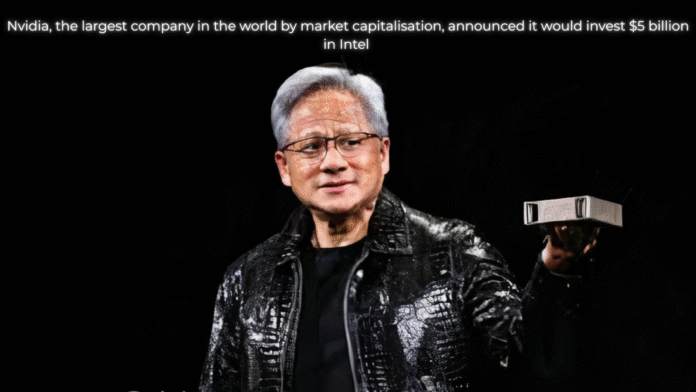The tech world is buzzing. Rumors are swirling about a seismic shift in the semiconductor industry. Imagine this: Nvidia, the undisputed king of AI and GPU tech, investing a massive Nvidia $5 Billion Investment in Intel, a legacy giant grappling with its future. This isn’t just a deal; it’s a potential paradigm shift. .
Let’s be real. On the surface, this sounds like a plot twist straight out of a Hollywood blockbuster. These two companies have been fierce rivals for decades. For years, they’ve competed for market dominance, constantly one-upping each other. So, what’s the real story here? More importantly, what would this partnership mean for the future of tech?
A Glimpse into the Hypothetical Deal
Right now, this is a “what if” scenario. But the mere possibility is sparking huge conversations. An investment of this magnitude from Nvidia into Intel would signal a dramatic change in strategy. Instead of pure competition, we could be looking at a future of collaboration.
This kind of power play would be a win-win for both parties. For one thing, Nvidia gets access to Intel’s vast manufacturing capabilities. Intel, on the other hand, gets a much-needed capital injection and, perhaps more importantly, a lifeline to stay relevant in the AI revolution. Learn more about AI and its future
Why Nvidia Would Make This Move: A Strategic Masterstroke
Nvidia is at the top of its game. Its GPUs are the gold standard for AI, powering everything from large language models to self-driving cars. However, this hyper-growth comes with a bottleneck: supply. The demand for Nvidia’s chips is unprecedented, and the company is struggling to meet it. Consequently, lead times for their products are stretching, and they are constantly battling supply chain issues.
This is where Intel comes in. Intel has long been a manufacturing powerhouse. They have advanced fabs (fabrication plants) and a deep understanding of chip production. Therefore, by investing in Intel, Nvidia could potentially secure a dedicated manufacturing pipeline for its chips. This move would reduce its dependence on its current foundry partners like TSMC, creating a more resilient and flexible supply chain. It’s about securing their AI dominance for the long term.
Additionally, this partnership could open new doors. Nvidia’s software ecosystem, including CUDA, is a key competitive advantage. By working with Intel, they could optimize their software to run on Intel’s architecture. In essence, it’s a symbiotic relationship where Nvidia’s software expertise meets Intel’s hardware prowess.
Also check our article for more on AI breakthroughs, Mark Zuckerberg’s AI strategy isn’t just about catching up with ChatGPT or Gemini — he envisions a future where Meta builds its own powerful AI ecosystem.
Why Intel Would Say “Yes”: A Lifeline in a Turbulent Sea
Intel has had a tough few years. They’ve faced stiff competition and have been slow to adapt to the new age of AI. While they are still a tech titan, their market share has been eroded, and their stock performance has lagged. As a result, they are under immense pressure to turn things around.
A $5 billion investment from Nvidia would be a game-changer for them. First and foremost, it provides the capital needed to invest in R&D and modernize their manufacturing facilities. This is crucial for their long-term survival. Furthermore, it sends a powerful message to the market: Intel is still a key player, and industry leaders believe in its future.
More than that, this partnership would give Intel a front-row seat to the AI revolution. They could leverage Nvidia’s expertise to accelerate their own AI chip development. Ultimately, this could help them reclaim their position as a tech innovator.
The Ripple Effect: Winners and Losers in the Tech Landscape
If this deal were to happen, the ripple effects would be huge.
- Winners:
- Nvidia: Secures its supply chain, strengthens its market position, and solidifies its role as the AI leader.
- Intel: Gets a capital boost, a strategic partner, and a chance to pivot into the future.
- The Industry: The partnership could lead to incredible innovation. For instance, a combination of Nvidia’s GPUs and Intel’s CPUs could create powerful, integrated solutions.
- Losers:
- TSMC: Nvidia’s current primary manufacturing partner could see a reduction in orders, which could potentially impact its revenue.
- AMD: AMD, a rival to both Nvidia and Intel, would face an even more powerful and integrated competitor.
- Consumers: While a long-term benefit of innovation is likely, short-term, a single dominant partnership could limit competition and potentially lead to higher prices.
The Road Ahead: Challenges and Opportunities
A partnership of this magnitude is not without its challenges. There would be significant cultural and operational hurdles to overcome. Specifically, getting two long-standing rivals to work together seamlessly is no easy feat. Issues around intellectual property, product roadmaps, and corporate governance would need to be meticulously ironed out. Moreover, regulatory bodies would scrutinize the deal to ensure it doesn’t create a monopolistic environment.
In conclusion, while this remains a hypothetical scenario, the possibility of an Nvidia investment in Intel is a hot topic for a reason. It represents a potential transformation of the tech landscape. Rather than a simple transaction, it’s a strategic alliance that could redefine the future of semiconductors and AI. It’s a testament to the idea that in today’s fast-paced tech world, yesterday’s rivals can become tomorrow’s partners. Ultimately, such a move would be the ultimate game changer.





